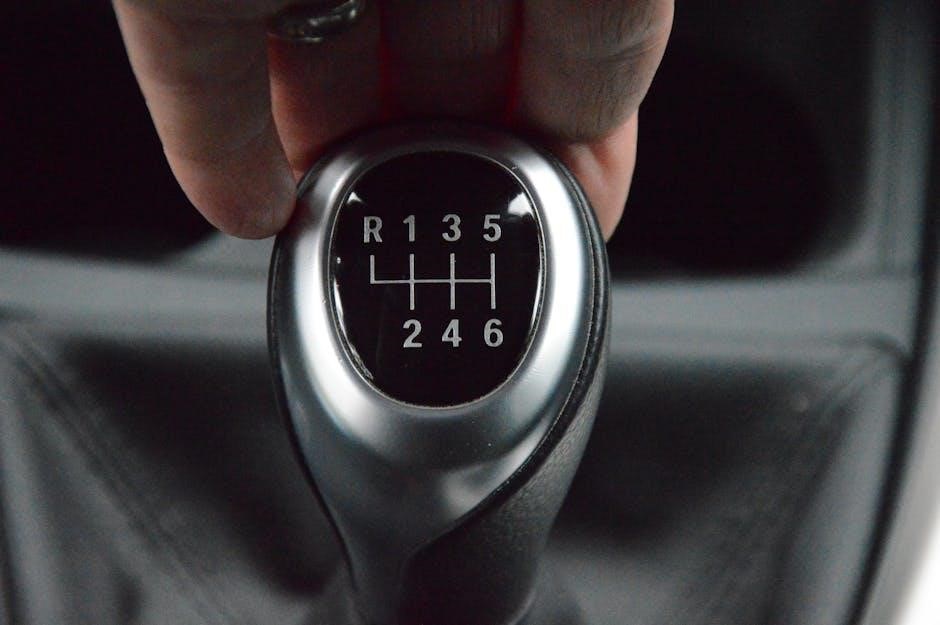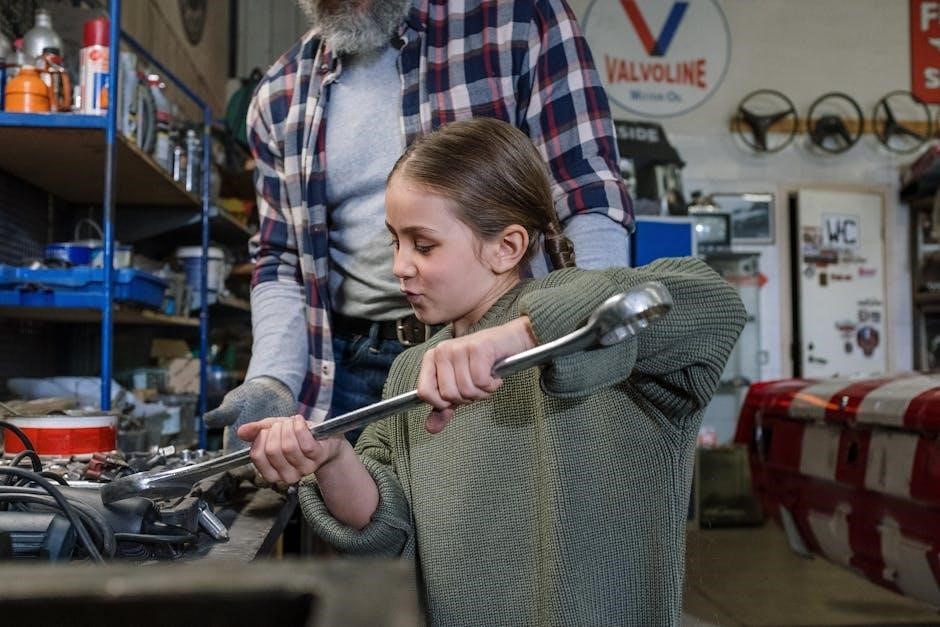Manual transmission, also known as stick shift, allows drivers to control gear changes, enhancing driving control and efficiency. It typically takes 1-3 weeks to learn basics, but mastery varies based on practice and experience. Understanding the clutch and gearshift is key, as it connects the driver to the vehicle’s mechanics, offering a more engaging driving experience compared to automatics.
What is Manual Transmission?
A manual transmission, often called a stick shift, is a type of vehicle transmission that requires the driver to manually change gears using a clutch pedal and a gearshift. This system allows the driver to control the flow of power from the engine to the wheels, providing more direct control over the vehicle’s acceleration and deceleration. The clutch pedal disengages the engine from the transmission, enabling smooth gear shifts. Manual transmissions are known for their fuel efficiency, lower cost, and enhanced driving engagement compared to automatic transmissions. They are popular in many regions and are often preferred by driving enthusiasts who enjoy the connection to the vehicle’s mechanics.
Importance of Learning Manual Transmission
Learning manual transmission is essential for drivers seeking greater control and connection to their vehicle. It offers improved fuel efficiency, lower maintenance costs, and enhanced driving engagement. Mastering manual transmission allows drivers to handle various road conditions more effectively, such as inclines and tight corners, by manually adjusting gear ratios. Additionally, it provides a deeper understanding of vehicle mechanics, fostering a more engaged and skillful driving experience. In many regions, knowing how to drive a manual car is highly valued and can be a practical skill for accessing a wider range of vehicles. Overall, it enhances driving proficiency and offers long-term benefits for both everyday commuting and adventurous driving scenarios.

Factors Influencing the Learning Time
Prior driving experience, frequency of practice, individual learning pace, and type of vehicle significantly influence how quickly one masters manual transmission, affecting the overall learning curve and progress.
Prior Driving Experience
Prior driving experience plays a crucial role in learning manual transmission. Drivers familiar with automatic vehicles may find it easier to adapt, as they already understand basic driving mechanics. Those with experience in stick-shift cars can transition faster, having muscle memory for clutch and gear coordination. Even experience with bicycles or motorcycles, which require manual gear shifting, can provide a foundation. New drivers, however, may need more time to grasp both driving fundamentals and manual transmission simultaneously. The existing skill set significantly influences the learning pace, making prior experience a key factor in mastering manual transmission efficiently.
Frequency and Quality of Practice
The frequency and quality of practice significantly impact the time it takes to learn manual transmission. Consistent practice helps build muscle memory and improves coordination between the clutch and gearshift. Focused, regular sessions, even if short, yield better results than irregular or lengthy ones. Practicing in a controlled environment, such as an empty parking lot, allows learners to concentrate on mastering specific skills, like smooth shifting and clutch control, without distractions. High-quality practice involves deliberate attention to technique, ensuring each action becomes second nature. Over time, this dedication leads to greater confidence and proficiency in handling the vehicle, making the learning process more efficient and effective.
Individual Learning Pace
The time it takes to learn manual transmission varies significantly based on individual learning pace. Some drivers pick up the basics within a few days, while others may need several weeks to feel comfortable. Factors such as prior driving experience, natural coordination, and the ability to quickly grasp the relationship between the clutch and gears play a role. For example, someone with a background in driving or mechanical skills may progress faster. However, even those without experience can master manual transmission with patience. It’s important to recognize that learning is not a one-size-fits-all process, and consistent effort is key to overcoming the initial challenges;
Type of Vehicle
The type of vehicle can influence the time it takes to learn manual transmission. Cars with smoother clutches and precise gearshifts, such as modern compact vehicles, are generally easier to handle for beginners. Larger vehicles or those with heavier clutch pedals may require more effort and practice. Additionally, vehicles with close-ratio gears can make shifting more intuitive, while those with wider ratios might feel less forgiving. The overall mechanical feel of the car plays a significant role in how quickly someone adapts to driving a manual. Starting with a vehicle that has a reputation for being driver-friendly can make the learning process less intimidating and more efficient.
The Learning Process
Mastery of manual transmission involves understanding clutch control, smooth shifting, and real-world application. The process starts with stationary practice, progresses to open spaces, and culminates in handling various driving scenarios, ensuring a well-rounded skill set.
Understanding the Clutch and Gearshift
Mastery of the clutch and gearshift is foundational to learning manual transmission. The clutch pedal disconnects the engine from the transmission, allowing smooth gear transitions. Proper technique involves pressing the clutch fully, shifting gears with the stick, and slowly releasing while accelerating. The gearshift operates through a mechanical linkage, requiring precise movements to align gears correctly. Practice is essential to develop muscle memory and coordination between clutch and accelerator pedals. Initial practice in a stationary vehicle helps build familiarity with the clutch’s “biting point,” where the engine engages with the transmission. This understanding is critical for smooth starts and seamless shifting.
Practicing in a Stationary Vehicle
Practicing in a stationary vehicle is the first step in mastering manual transmission. With the parking brake engaged and in a safe, flat area, learners can focus on coordinating the clutch and gearshift without the pressure of moving. Start by pressing the clutch fully and shifting through all gears to understand the mechanical feel. Practice shifting smoothly, listening to the engine’s RPMs to gauge when to release the clutch. This initial practice helps develop the muscle memory needed for real-world driving scenarios. It’s essential to keep the vehicle stationary to avoid stalling or jerking, allowing learners to build confidence and control before progressing to moving conditions.
Starting with a Flat, Open Area
Once comfortable with the clutch and gearshift in a stationary vehicle, the next step is practicing in a flat, open area. This allows learners to focus on coordinating the clutch and accelerator while the vehicle is in motion. Find a large, empty space like a parking lot to minimize obstacles and distractions. Start by shifting into first gear and gradually releasing the clutch while pressing the accelerator. Practice moving forward, stopping, and shifting into higher gears. Straight-line driving helps build confidence before tackling turns or inclines. Regular practice in this controlled environment is crucial for improving smooth transitions and reducing stalling. Over time, learners will develop the coordination needed for seamless gear changes.
Gradually Moving to Inclines and Declines
After mastering flat areas, learners should progress to inclines and declines to refine their control. Start with gentle slopes to practice balancing the clutch and accelerator. Uphill driving requires precise coordination to avoid stalling, while downhill driving demands careful use of the brake and lower gears to maintain control. These scenarios teach how to manage vehicle speed and momentum effectively. Practice shifting gears smoothly while navigating slopes, focusing on seamless transitions. Over time, this builds confidence and improves the ability to handle various road conditions. Regular practice on inclines and declines helps learners develop advanced control and prepares them for real-world driving challenges.
Real-World Driving Scenarios
Real-world driving scenarios expose learners to diverse conditions, such as heavy traffic, tight spaces, and uneven roads. Practicing in these environments helps refine skills like quick gear shifts and clutch control. Learners must adapt to situations like merging onto highways, navigating roundabouts, or stopping on inclines. These scenarios teach how to anticipate and react to challenges, such as sudden stops or changing speed limits. Consistent exposure to real-world driving builds confidence and reduces hesitation. Start with familiar routes and gradually tackle more complex situations, focusing on smooth transitions and maintaining control. Over time, these experiences make learners more adept at handling the unpredictability of everyday driving, enhancing their overall mastery of manual transmission;

Tips for Mastering Manual Transmission
Mastering manual transmission requires consistent practice, starting in stationary vehicles and progressing to real-world scenarios. Use instructional resources and focus on smooth clutch engagement for better control.
Choosing the Right Practice Environment
Selecting a suitable environment is crucial for learning manual transmission. Begin in a flat, open space like an empty parking lot to avoid obstacles and reduce stress. Avoid inclines initially, as they can complicate clutch control. Ensure the area is free from traffic to allow focus on gear shifts and clutch coordination. As confidence grows, gradually introduce varied terrains such as slight inclines or declines. Real-world scenarios, like stopping and starting on hills, should be tackled once basic skills are mastered. A safe and controlled setting helps build proficiency without the pressure of traffic, making the learning process more effective and enjoyable.
Using Instructional Resources
Utilizing instructional resources can significantly accelerate the learning process. Online tutorials, videos, and guides provide step-by-step instructions for mastering manual transmission. Books and forums offer detailed insights and tips from experienced drivers. Practice alongside these resources helps reinforce learning. Use specific search queries with Boolean operators to find relevant materials. For example, “how to shift gears smoothly” or “manual transmission tips for beginners.” Creating a structured study plan and tracking progress ensures consistent improvement. Combining theoretical knowledge with practical application enhances retention and skill development. These tools empower learners to overcome challenges and build confidence behind the wheel.
Practicing Regularly
Consistent practice is crucial for mastering manual transmission. Regular sessions help develop muscle memory and improve coordination between the clutch and accelerator. Even short daily practices, like 15-20 minutes, can yield significant progress. Frequency reinforces learning, making it easier to handle various driving scenarios. Start with stationary practice, then gradually move to open spaces before tackling real-world conditions. Over time, actions like shifting gears become second nature. Without regular practice, skills can stagnate, making progress slower. Dedication and consistent effort are key to becoming proficient in manual transmission driving within a reasonable timeframe.

Common Challenges and Solutions
Learning manual transmission often involves overcoming stalling, riding the clutch, and difficulty shifting gears smoothly. These challenges require patience, practice, and understanding of clutch control mechanics to master effectively.
Stalling the Vehicle Frequently
Stalling is a common issue when learning manual transmission. It occurs when the driver doesn’t coordinate the clutch release with accelerator input. Overcoming this requires practice in balancing these controls. Novice drivers often release the clutch too quickly or apply too little throttle. To avoid stalling, focus on slowly lifting the clutch while gently pressing the accelerator. Practicing in a stationary vehicle or on flat ground helps build muscle memory. Consistent practice reduces stalling frequency, improving overall control and confidence behind the wheel. Patience is key, as mastering this skill is a fundamental step in learning manual transmission effectively.
Riding the Clutch
Riding the clutch, or keeping it partially engaged, is a bad habit that can damage the clutch and related components. It occurs when the driver rests their foot on the clutch pedal without fully releasing it. This causes unnecessary wear on the clutch disc and pressure plate. Over time, this can lead to premature wear and costly repairs. To avoid riding the clutch, drivers should keep their foot fully off the pedal when not shifting gears. Practicing proper foot placement and developing muscle memory through consistent practice helps break this habit. Avoiding this issue ensures smoother gear transitions and extends the lifespan of the clutch, making the learning process more efficient and effective.
Difficulty with Shifting Gears Smoothly
One common challenge when learning manual transmission is difficulty with shifting gears smoothly. This often results from improper coordination between the clutch pedal and accelerator. New drivers may struggle to find the “biting point” where the engine connects with the wheels, leading to jerky movements. To overcome this, practice in a stationary vehicle to develop muscle memory and timing. Start in a flat, open area to minimize distractions and gradually progress to inclines. Consistent practice helps refine the feel of the clutch and gearshift, enabling smoother transitions. Patience is key, as mastering this skill requires time and repetition to build confidence and control behind the wheel.

Why Learn Manual Transmission?
Learning manual transmission enhances driving control, offers cost efficiency, and provides a deeper connection to the driving experience, making it a valuable skill for any driver.
Cost Efficiency
Learning manual transmission offers significant cost benefits. Vehicles with manual transmissions are often cheaper to purchase and maintain. They typically consume less fuel, reducing long-term expenses. Additionally, manual cars tend to have lower repair costs since they have fewer complex components compared to automatics. This makes them a budget-friendly option for drivers. Over time, the savings from fuel efficiency and lower maintenance can offset the initial effort of learning. Furthermore, manual vehicles often retain better resale value, providing financial advantages even when upgrading. These economic benefits make mastering manual transmission a practical choice for cost-conscious drivers seeking long-term savings.
Better Control Over the Vehicle

Manual transmission provides drivers with greater control, allowing precise gear selection to match driving conditions. This direct connection enhances responsiveness, especially during uphill climbs or sudden acceleration. Drivers can optimize engine braking for downhill descents, reducing wear on brakes. The ability to manually shift gears enables smoother navigation of curves and better handling in heavy traffic. This heightened control fosters a deeper connection between the driver and the vehicle, making the driving experience more engaging. Mastery of manual transmission empowers drivers to adapt to various road scenarios confidently, ensuring improved safety and driving precision. This level of control is often cited as a key reason for learning manual driving.
Connection with the Driving Experience
Learning manual transmission fosters a deeper connection with the driving experience, as it requires active engagement with the vehicle. Drivers must synchronize clutch and accelerator pedals while selecting gears, creating a sense of rhythm and harmony. This hands-on interaction makes driving feel more intentional and immersive, as the driver becomes one with the car. The tactile feedback from the clutch and gearshift enhances sensory involvement, making every drive more rewarding. Over time, mastering manual transmission builds confidence and satisfaction, as the driver feels more connected to the vehicle’s performance and handling. This connection often leads to a greater appreciation for the art of driving itself.

Manual vs. Automatic Transmission
Manual transmission offers better fuel efficiency and control, making it popular among driving enthusiasts. Automatics prioritize convenience, especially in heavy traffic, while manuals provide a more engaging experience.
Differences in Driving Experience
Manual transmission driving requires active engagement, as drivers must coordinate clutch and gearshift actions, offering precise control over speed and torque. This creates a more immersive experience, with a direct connection to the vehicle’s performance. Automatic transmissions, by contrast, automate gear changes, reducing driver input and providing a smoother, more convenient ride. The manual driving experience fosters a deeper understanding of the vehicle’s mechanics and enhances driver skill, while automatics prioritize ease and comfort, especially in stop-and-go traffic. The choice between the two often comes down to personal preference, driving conditions, and the desired level of control and engagement behind the wheel.
Popularity in Different Regions
Manual transmissions are more popular in Europe and Asia, where fuel efficiency and lower vehicle costs are prioritized. In North America, automatics dominate due to traffic patterns and cultural preferences. Emerging markets often favor manuals for affordability, while developed regions lean towards automatics for convenience. This regional variance highlights how driving habits, economic factors, and lifestyle influence transmission preferences, shaping the global automotive landscape and driver experiences.
Learning manual transmission varies by individual, taking 1-3 weeks for basics and months for mastery. Consistent practice and patience are key to becoming proficient in manual driving.
Learning manual transmission time varies, typically ranging from 1-3 weeks for basic proficiency to several months for mastery. Key factors influencing this include prior driving experience, frequency and quality of practice, and individual learning pace. Understanding the clutch and gearshift mechanics is foundational, followed by practicing in a stationary vehicle and gradually progressing to real-world scenarios. Consistent practice in a suitable environment and using instructional resources can accelerate the process. Common challenges like stalling and smooth shifting improve with patience and repetition. Mastery enhances control and connection with the vehicle, making the effort worthwhile for those committed to learning.
Encouragement for Consistent Practice
Consistent practice is crucial for mastering manual transmission. Even short daily sessions can lead to significant progress. Celebrate small victories, like smoother shifts or fewer stalls, to stay motivated. Real-world experience builds confidence and skill, so gradually challenging yourself is key. Patience is essential, as improvement takes time. Embrace each practice session as an opportunity to refine your technique and connect more deeply with the driving experience. Remember, persistence pays off, and the satisfaction of mastering manual transmission is rewarding and lasts a lifetime.